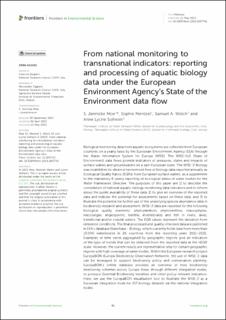| dc.contributor.author | Moe, S. Jannicke | |
| dc.contributor.author | Mentzel, Sophie | |
| dc.contributor.author | Welch, Samuel Alexander Stafford | |
| dc.contributor.author | Solheim, Anne Lyche | |
| dc.date.accessioned | 2023-09-21T14:24:34Z | |
| dc.date.available | 2023-09-21T14:24:34Z | |
| dc.date.created | 2023-08-08T15:51:15Z | |
| dc.date.issued | 2023 | |
| dc.identifier.citation | Frontiers in Environmental Science. 2023, 11, 1-13. | en_US |
| dc.identifier.issn | 2296-665X | |
| dc.identifier.uri | https://hdl.handle.net/11250/3091147 | |
| dc.description.abstract | Biological monitoring data from aquatic ecosystems are collected from European countries on a yearly basis by the European Environment Agency (EEA) through the Water Information System for Europe (WISE). The WISE-SoE (State of Environment) data flows provide indicators of pressures, states and impacts of surface waters and groundwaters on a pan-European scale. The WISE-2 Biology was established to obtain a harmonised flow of biology data reported annually as Ecological Quality Ratios (EQRs) from European surface waters, as a supplement to the mandatory 6-yearly reporting of ecological status of water bodies for the Water Framework Directive. The purposes of this paper are 1) to describe the compilation of national aquatic biology monitoring data indicators and to inform about the public availability of these data, 2) to give an overview of the reported data and indicate the potential for assessments based on these data, and 3) to illustrate the potential for further use of the underlying species abundance data in biodiversity research and assessment. WISE-2 data are reported for the following biological quality elements: phytoplankton, phytobenthos, macrophytes, macroalgae, angiosperms, benthic invertebrates and fish in rivers, lakes, transitional and/or coastal waters. The EQR values represent the deviation from reference conditions. The final processed and quality-checked data are published in EEA’s database Waterbase - Biology, which currently holds data from more than 13,000 waterbodies in 26 countries from the reporting years 2011–2021. Examples of time series aggregated by geographic regions give an indication of the type of trends that can be obtained from the reported data at the nEQR scale. However, the current results are representative only for certain geographic regions with high coverage of water bodies. Within the European research project EuropaBON (Europa Biodiversity Observation Network), the use of WISE-2 data can be leveraged to support biodiversity policy and conservation planning. EuropaBON’s online database provides an overview of how biodiversity monitoring schemes across Europe flows through different integration nodes, to produce Essential Biodiversity Variables and other policy-relevant indicators. Here, we use the EuropaBON visualisation tool to illustrate the WISE-2 as a European integration node for 157 biology datasets via the national integration nodes. | en_US |
| dc.language.iso | eng | en_US |
| dc.publisher | Frontiers | en_US |
| dc.rights | Navngivelse 4.0 Internasjonal | * |
| dc.rights.uri | http://creativecommons.org/licenses/by/4.0/deed.no | * |
| dc.title | From national monitoring to transnational indicators: reporting and processing of aquatic biology data under the European Environment Agency’s State of the Environment data flow | en_US |
| dc.type | Peer reviewed | en_US |
| dc.type | Journal article | en_US |
| dc.description.version | publishedVersion | en_US |
| dc.rights.holder | © 2023 The Authors | en_US |
| dc.source.pagenumber | 13 | en_US |
| dc.source.volume | 11 | en_US |
| dc.source.journal | Frontiers in Environmental Science | en_US |
| dc.identifier.doi | 10.3389/fenvs.2023.1057742 | |
| dc.identifier.cristin | 2165709 | |
| cristin.ispublished | true | |
| cristin.fulltext | original | |
| cristin.qualitycode | 1 | |

